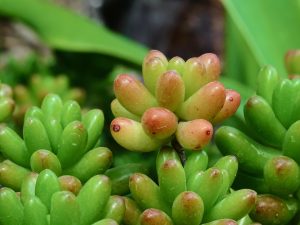
Plants such as wildflowers and sedum will absorb rainwater and help alleviate flooding
Two bus shelters in Oswestry town centre are being planted with ‘green roofs’ as part of the Severn Valley Water Management Scheme’s Oswestry de-pave demonstrator project.
Shropshire Wildlife Trust, which is delivering the demonstrator project, has granted £7,000 for oxygen boosting sedums and wildflowers to be planted on the roofs of the bus shelters on Black Gate Street and on Willow Street.
Pete Lambert, SVWMS demonstrator project manager, said: “The de-pave project is an initiative aimed at making public spaces in urban Oswestry more water-friendly.
“It focuses on adapting these spaces by implementing green infrastructure such as green roofs, tree pits, rain gardens, and Sustainable Drainage Systems (SuDS), which will allow water to soak into the ground more easily, reducing surface water flooding and improving climate resilience.”
Luke Neal, for Shropshire Wildlife Trust, added: “We are delighted to be working with Oswestry Town Council under the Severn Valley Water Management Scheme to bring these new green bus shelters to the town.
“Not only will they capture rainwater and slow its release down to help reduce surface water flooding, but they will have ecological benefits by being attractive to bees and pollinators.
“It all starts with small steps and under the Oswestry de-pave demonstrator project we will be working hard to deliver more schemes like this one so that little bits of nature can help us a little bit more.”
The SVWMS, is a partnership between the EA, Natural Resources Wales, Powys County Council and Shropshire Council with the intention to tackle flooding, support thriving communities and create resilient environments through sustainable and holistic water management.
The Demonstrator Programme, managed by Shropshire Council, is being delivered across the Upper Severn catchment and provide an opportunity to both showcase nature-based solutions in action, as well as test new concepts and research ideas that will support the longer-term approach to water management at a catchment scale.
It is anticipated that the programme will deliver 108 hectares of improved habitat and 11.5 kilometres of improved river habitat before it concludes in 2027.
Details of the individual projects can be found here on the SVWMS website.



